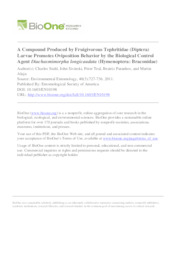A Compound produced by fruigivorous Tephritidae (Diptera) larvae promotes oviposition behavior by the biological control agent Diachasmimorpha longicaudata (Hymenoptera: Braconidae).
A Compound produced by fruigivorous Tephritidae (Diptera) larvae promotes oviposition behavior by the biological control agent Diachasmimorpha longicaudata (Hymenoptera: Braconidae).
Author(s): STUHL, C.; SIVINSKI, J.; TEAL, P.; PARANHOS, B. A. J.; ALUJA, M.
Summary: Tephritid fruit ßy parasitoids use fruit-derived chemical cues and the vibrations that result from larval movements to locate hosts sequestered inside fruit. However, compounds produced by the larvae themselves have not been previously described nor their signiÞcance to parasitoid foraging determined. We collected the volatiles from four species of tropical and subtropical Tephritidae: Anastrepha suspensa (Loew), Bactrocera dorsalis Hendel, Bactrocera cucurbitae Coquillett, and Ceratitis capitata (Wiedemann), representing two subfamilies (Dacinae and Trypetinae). Paraethylacetophenone, an analog of a known tephritid parasitoid attractant, was a major constituent of all four, and was not associated with larvae of another acalypterate ßy, Drosophila melanogaster Meigen, or with the calypterate Musca domestica L. It also was present in volatiles from whole, A. suspensa infested fruits of Eugenia uniflora (L.). Para-ethylacetophenone was not necessarily produced as a direct consequence of fruit consumption because it also was detected from larvae that developed in two artiÞcial diets and in spent diets subsequent to larval development. Sensillae on both the antennae and ovipositor of the opiine braconid fruit ßy parasitoid, Diachasmimorpha longicaudata (Ashmead) responded to the para-ethylacetophenone in larval volatiles and as a synthetic. Although a potential cue to foraging parasitoids, para-ethylacetophenone showed no long range (1m) at- tractiveness to the adult female parasitoid, but did stimulate ovipositor-insertion and oviposition into both a natural (fruit) and an artiÞcial (paraÞlm) substrate. Thus it may prove useful in colonizing and mass-rearing opine fruit ßy parasitoids.
Publication year: 2011
Types of publication: Journal article
Unit: Embrapa Semi-arid Region
Observation
Some of Embrapa's publications are published as ePub files. To read them, use or download one of the following free software options to your computer or mobile device. Android: Google Play Books; IOS: iBooks; Windows and Linux: Calibre.
Access other publications
Access the Agricultural Research Database (BDPA) to consult Embrapa's full library collection and records.
Visit Embrapa Bookstore to purchase books and other publications sold by Embrapa.

